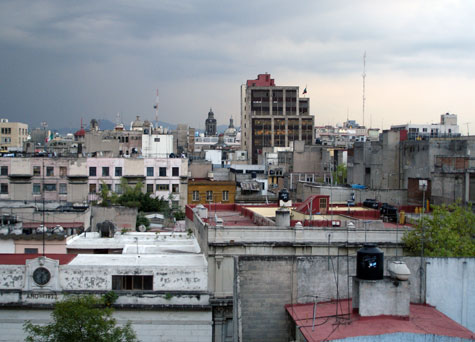Archive for October 6th, 2007
Carreta Nagua Siglo 21, day 1
Friday, October 5th was the first day on getting started in assembling the physical component of my TRANSITIO commission for “impolis”, one of a series of curatorial components that make up TRANSITIO_MX02, the second installment of this new media festival in Mexico City.
I’m building a rickshaw that will tour people around a park in the historical center of Mexico City, Parque Alameda. As people take a ride on the rickshaw that I will pull, they will watch an animation that I’ve been creating over the last few months. Carreta Nagua is an old folk tale from Nicaragua, tale generally told to children when they refuse to go to sleep, because it’s a wagon (carreta) driven by death and pulled by two skeletal oxen, it makes a great deal of noise, as if chains were been dragged along the ground as it makes it way. When the Carreta Nagua arrives at ones home, the person is sure to die. It’s assumed that the tale, a very old tale shared amongst the indeginous people of Nicaragua, but also having many parallels throughout Latin America, is believed to have been established due to the slave carts driven by the Spaniards to take slaves to the mines. People taken by the carts would disappear, only to be seen again as corpses. The Spanish would take indeginous people to the mines to work, where they would wear away to die and be taken as corpses for burial. When indeginous people heard a cart, they would hide, the cart became a symbol of death.
The animation featured on the cart, on a panel that sits in front of the passenger is based on my parents. They left Nicaragua over 40 years ago, to work and establish a family and to give their children greater possibilities. Now they are returning to Nicaragua, but it’s an entirely different place than the one that they left. “La Carreta Nagua” is an allegory for the translocation of people, the leaving of ones culture, extended family, language – for greater means or opportunities / for economic reasons in a pancapitalist era. This is the personal or subjective or individual portion of globalization, not the corporate form of globalization, but the mass migration of populations due to highly subjective decisions by individuals.
So Friday was day one, when I was taken by Juan and Israel to “deshuesadores” – one translation might be skeleton cleaners, but really auto wreck dumps. The rickshaw needs an axle, tires, seats, a steel frame… all parts that can be found at an auto dump. I’d been concerned at how all this would come together, but it went smoother than I could have imagined. At our second stop we acquired nearly all the primary parts and at a fraction of the price that the curators had set aside for the project. One of my goals was to assemble this piece entirely from recycled parts and not to use new materials, so far so good. Here are a few shots documenting day one.
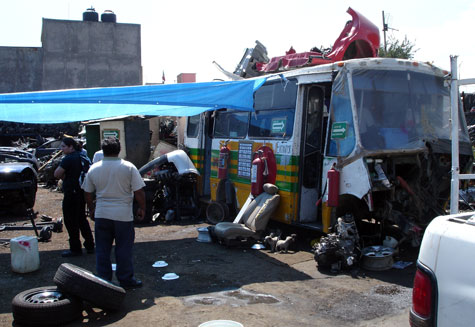
This auto wreck site revitalized an old bus as its office. To the right is the office and beyond is surplus of old and new cars and parts that can no longer function as designed.
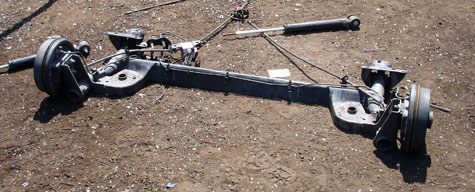
I showed a kid working the site a few drawings, explained what we were building and asked for specific parts and he pulled out an ideal axle, a unit nearly ready to go that would be wide enough to seat two above. We bartered down the price by leaving the shocks that were on the axle. Every single piece has a value.
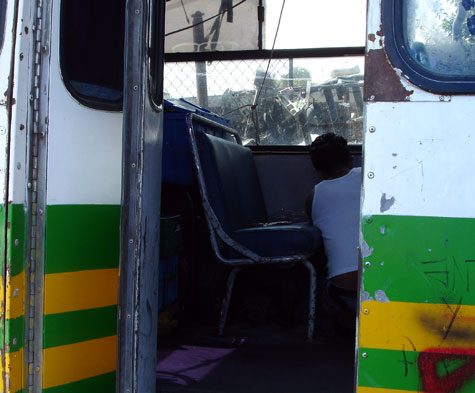
After we asked for seats, he showed us a few car seats, mostly bucket seats from recent cars, but they weren’t what I was looking for. I looked into the office and saw the bus seat near the backdoor and told the guys that were taking me around that that was what I was interested in and they said well, let them know. I did, they gave us a price, we haggled and we got it. Everything is for sale, event sections from the business office.
Their tire prices seemed high, so our driver suggested that we try a few tire repair places, such as the one below. Set up on a corner, one can pick up a new tire on the fly, such as the one below
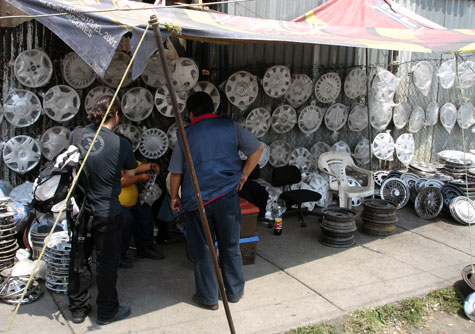
After a day that started with a long and crowded metro ride and continued into several hours of driving around Mexico City in increasingly terrific traffic and haggling for car parts, I was taken by Antonio, the exhibition administrator who took car of all the public art permits to a very old taco place in the town center. Then we had a couple tequilas on his deck overlooking Mexico City’s downtown.
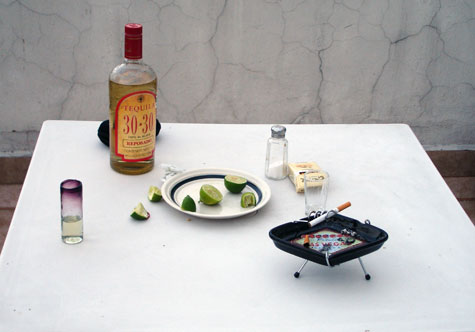
A view of Mexico City’s historical downtown from a 5th story deck
